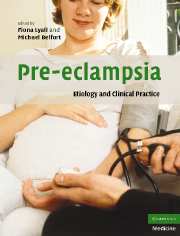Book contents
- Frontmatter
- Contents
- List of contributors
- Preface
- Part I Basic science
- Part II Clinical Practice
- 17 Classification and diagnosis of pre-eclampsia
- 18 Measuring blood pressure in pregnancy and pre-eclampsia
- 19 Immune maladaptation in the etiology of pre-eclampsia; an updated epidemiological perspective
- 20 Genetics of pre-eclampsia and counseling the patient who developed pre-eclampsia
- 21 Thrombophilias and pre-eclampsia
- 22 Medical illness and the risk of pre-eclampsia
- 23 The kidney and pre-eclampsia
- 24 Management of mild pre-eclampsia
- 25 Management of severe pre-eclampsia
- 26 The differential diagnosis of pre-eclampsia and eclampsia
- 27 Complications of pre-eclampsia
- 28 Central nervous system findings in pre-eclampsia and eclampsia
- 29 Pathogenesis and treatment of eclampsia
- 30 Anesthesia for the pre-eclamptic patient
- 31 Critical care management of severe pre-eclampsia
- 32 The role of maternal and fetal Doppler in pre-eclampsia
- 33 Pregnancy-induced hypertension – the effects on the newborn
- 34 Medico-legal implications of the diagnosis of pre-eclampsia
- Subject index
- References
22 - Medical illness and the risk of pre-eclampsia
from Part II - Clinical Practice
Published online by Cambridge University Press: 03 September 2009
- Frontmatter
- Contents
- List of contributors
- Preface
- Part I Basic science
- Part II Clinical Practice
- 17 Classification and diagnosis of pre-eclampsia
- 18 Measuring blood pressure in pregnancy and pre-eclampsia
- 19 Immune maladaptation in the etiology of pre-eclampsia; an updated epidemiological perspective
- 20 Genetics of pre-eclampsia and counseling the patient who developed pre-eclampsia
- 21 Thrombophilias and pre-eclampsia
- 22 Medical illness and the risk of pre-eclampsia
- 23 The kidney and pre-eclampsia
- 24 Management of mild pre-eclampsia
- 25 Management of severe pre-eclampsia
- 26 The differential diagnosis of pre-eclampsia and eclampsia
- 27 Complications of pre-eclampsia
- 28 Central nervous system findings in pre-eclampsia and eclampsia
- 29 Pathogenesis and treatment of eclampsia
- 30 Anesthesia for the pre-eclamptic patient
- 31 Critical care management of severe pre-eclampsia
- 32 The role of maternal and fetal Doppler in pre-eclampsia
- 33 Pregnancy-induced hypertension – the effects on the newborn
- 34 Medico-legal implications of the diagnosis of pre-eclampsia
- Subject index
- References
Summary
Introduction
Many different medical illnesses predispose women to pre-eclampsia. Some of these are logical, well known, and accepted, such as pre-existing hypertension or diabetes. Others are less well known or more controversial, such as migraine and asthma. Correct identification of women at increased risk for pre-eclampsia allows appropriate channeling of antenatal care and allocation of resources to maximize the chances of early diagnosis and appropriate management. In addition, strategies to screen for and prevent pre-eclampsia are often more effective in high-risk women. It is important that women with medical diseases associated with an increased risk of pre-eclampsia and the related complications of intrauterine growth restriction and prematurity are appropriately counseled, ideally prior to pregnancy. In many cases appropriate and optimal pre-conception control of the medical illness may reduce the risk of pre-eclampsia.
The risk factors for pre-eclampsia are listed in Table 22.1. This chapter will cover the general, obstetric and medical risk factors. These general and obstetric risk factors are discussed since, although not representing medical illness themselves, they may often complicate or coexist with medical illness. They may therefore add to the already elevated risk of pre-eclampsia associated with the medical illness, e.g. obese women who are more likely to be hypertensive. Medical illness may affect fertility resulting in a delay before child bearing or longer interbirth interval, e.g. women with renal failure who have reduced fertility. It is the individualized cumulative risk of these various factors that is important for clinical practice.
- Type
- Chapter
- Information
- Pre-eclampsiaEtiology and Clinical Practice, pp. 325 - 338Publisher: Cambridge University PressPrint publication year: 2007



